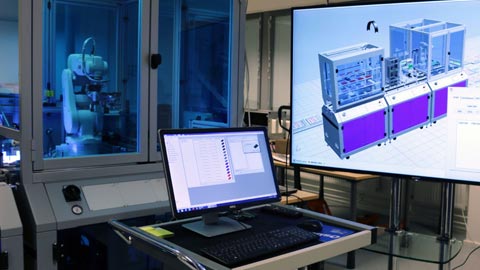Digitalization opportunities in an innovative learning environment
Digitalization opportunities in an innovative learning environment

Case Study
University partners with Siemens and IDEAL PLM to help add value for manufacturers while training the future workforce
Seinäjoki University of Applied Sciences
SeAMK uses a Digital Factory to enable Finnish firms to explore digitalization opportunities and create an innovative learning environment
Providing a global education
Seinäjoki University of Applied Sciences (SeAMK) is a multidisciplinary institution that plays a major role in education and research, development and innovation (RDI) in the region of South Ostrobothnia in Western Finland. SeAMK is an international university with 200 partner universities in 50 countries across the world.
The SeAMK research, development and innovation department is part of a regional university consortium, which also includes the Seinäjoki town council and the South Ostrobothnia region.
The Seinäjoki University of Applied Sciences offers a high-quality engineering education taught by qualified staff in modern laboratories with cutting-edge technology. The university uses its laboratories for teaching, testing services and research and development (R&D).
Business challenges
The efficiency, flexibility and agility of product development and production processes are essential factors in Finnish manufacturing, which faces intense competition from low-cost nations, providing significant challenges for the country and its educational sector. Manufacturers need to rapidly create new, innovative products and produce them cost effectively to succeed in a global environment.
The Internet of Things (IoT) and digitalization offer Finnish manufacturers many new development opportunities. However, since small and medium-sized enterprises (SMEs) have limited R&D resources and the technology is rapidly evolving, they often need a trusted partner, neutral advisor and trained staff to help them define how new technologies can be effectively applied in their business and engineering environments.
The opportunities for embracing the Industrial IoT and digitalization can only be realized if local manufacturers decide to become pioneers in this emerging technology. The purpose of the high-tech laboratories at SeAMK is to demonstrate the possibilities of technology and encourage enterprises to rapidly adopt them.
With a strong emphasis on the practical application of the design and engineering profession that matches industry requirements, SeAMK aims to provide its students with cutting-edge knowledge and skills that will make them highly employable graduates who can help their employers modernize their engineering know-how.
Identifying a need
SeAMK has a long history of pioneering in the digital manufacturing domain. Several technical laboratories have been developed over the years and new developments are regularly taking place. One of the projects includes the virtual reality laboratory called Cave Automatic Virtual Environment (CAVE), in which products, structures and parts can be analyzed in 3D.
The CAVE room is used for visualizing computer-generated 3D structures, objects and worlds in a virtual space where the viewer is surrounded by five display walls of computer-generated virtual reality (VR). Models designed with 3D computer-aided design (CAD) programs come to life in the virtual space. The 3D models can be visualized by using the VR software tools.
Siemens, like SeAMK, recognizes that with an aging workforce and fewer engineers, and technologists entering the workforce, there is going to be a talent shortage. SeAMK identified the need to bring local industry and students even closer together in the field of digital design and manufacturing in 2013. The SeAMK Digital Factory was developed in partnership with Siemens in Finland and Siemens Digital Industries Software partner IDEAL PLM by using the latest automation technologies and product lifecycle management (PLM) solutions to make the opportunities of the Industrial Internet and digitalization available to the students and the manufacturing sector. To validate the concept and develop the new initiative, more than 10 Ostrobothnian companies continuously provide invaluable information on their processes and requirements.
The SeAMK Digital Factory is an innovative, virtual learning environment for students, and a source of expertise for companies. It’s a real-world implementation of Siemens’ vision for digital enterprises, smoothly connecting major parts of the product and production lifecycle in a single environment.
In the virtual learning environment, students learn to operate machinery and use digital design programs to develop models and design production processes. Students recently developed fully functional robotized production cells.
In this center of expertise, companies’ products and production lines can be designed, conceptualized, simulated and tested as 3D models. For example, the ergonomics of a manufacturing process may be tested. With the aid of virtually simulated factory workers, it is possible to assess how well the planned process would work from the standpoint of efficiency, ergonomics and safety.
